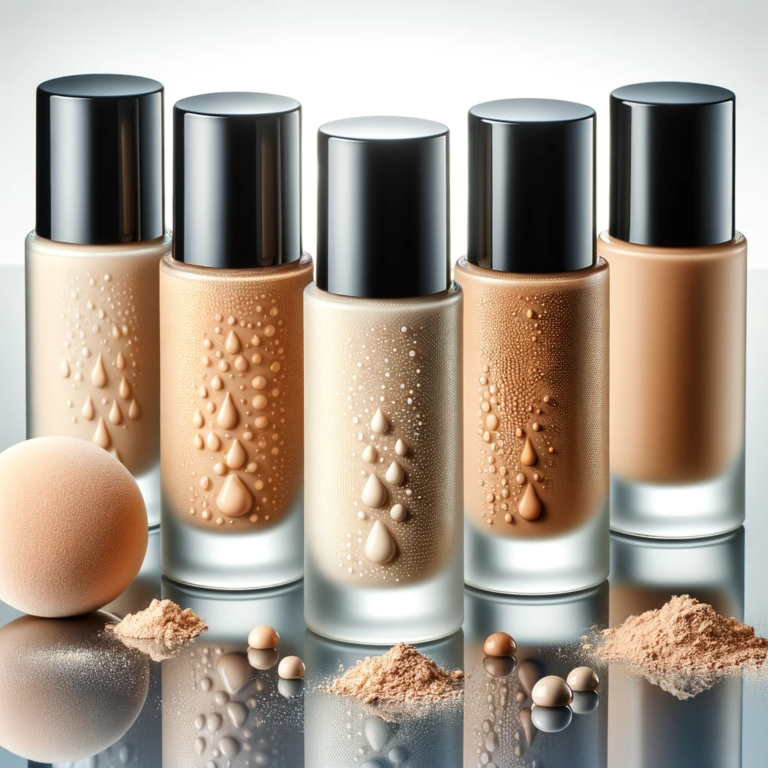Choosing The Right Foundation Shade For Your Skin Tone
Choosing the Right Foundation Shade for Your Skin Tone
Choosing The Right Foundation Shade For Your Skin Tone: Finding the perfect foundation shade can be a daunting task, as it’s crucial to match your complexion for a flawless, natural-looking finish. The key lies in understanding your skin tone and undertones, which can greatly impact the way a foundation blends and enhances your appearance. In this article, we’ll explore the art of selecting the right foundation shade to complement your unique skin tone.
Identifying Your Skin Tone
The first step in choosing the right foundation is to determine your skin tone. Skin tones can generally be categorized as fair, light, medium, tan, or deep. To assess your skin tone, examine the color of your skin in natural daylight, without any makeup. Consider the overall hue – is it more on the cooler (pinkish) or warmer (golden) side? This will help you narrow down the right foundation shade.
Recognizing Skin Undertones
Skin undertones are the subtle, underlying tones that can be cool (pink, red, or blue), warm (yellow, golden, or peachy), or neutral (a balance of cool and warm). Identifying your undertone is essential, as it will guide you towards foundations that blend seamlessly with your complexion. You can determine your undertone by examining the veins on the inside of your wrist – if they appear more blue or purple, you have cool undertones; if they appear more green, you have warm undertones; and if they are a mix of both, you have neutral undertones.
Selecting the Appropriate Foundation Shade
Once you’ve identified your skin tone and undertones, it’s time to start the search for the perfect foundation shade. When testing foundation, apply it along your jawline and blend it down the neck. This will help you see how the color interacts with your skin tone and ensures a seamless, harmonious look. If the foundation appears too light or too dark, keep trying different shades until you find the one that disappears into your skin.

Considering Skin Undertones in Foundation Selection
When selecting a foundation, pay close attention to the undertone. Cool-toned individuals may find that foundations with pink or blue-based undertones complement their complexion better, while warm-toned individuals may prefer foundations with yellow or golden undertones. Neutral-toned individuals have the flexibility to experiment with both cool and warm-toned foundations.
Adjusting for Seasonal Changes
It’s important to note that your skin tone can fluctuate throughout the year, often becoming more sun-kissed during the summer months and paler during the winter. To account for these seasonal changes, consider having a few foundation shades in your arsenal or opt for a foundation that can be easily customized by mixing in a darker or lighter shade.
Exploring Foundation Formulas
The type of foundation formula you choose can also impact the overall appearance and wear of the product. Liquid foundations tend to provide a more natural, luminous finish, while powder foundations can offer a more matte, long-wearing look. Cream or stick foundations are great for providing medium to full coverage, while BB or CC creams offer a more sheer, radiant finish.
Seeking Professional Assistance
If you’re still struggling to find the perfect foundation shade, don’t hesitate to seek assistance from a professional makeup artist or cosmetic counter associate. They can provide personalized recommendations and guidance based on your unique skin tone and undertones, ensuring you leave with a foundation that makes you look and feel your absolute best.
Choosing the right foundation shade is a journey of self-discovery and experimentation. By understanding your skin tone and undertones, exploring different foundation formulas, and seeking professional advice when needed, you can achieve a flawless, natural-looking complexion that enhances your natural beauty.
Understanding Your Skin’s Undertones
Determining your skin’s undertone is crucial when it comes to choosing the right foundation shade, selecting the most flattering makeup colors, and achieving a seamless, natural-looking complexion. Your skin’s undertone can be one of three main categories: warm, cool, or neutral. Identifying your undertone can be a game-changer in your makeup and beauty routine.
Recognizing Warm Undertones
Individuals with warm undertones often have a golden, peachy, or olive-tinted complexion. They may also have freckles, reddish or yellowish undertones to their skin, and tend to tan easily. When looking at the veins on their inner wrists, they may appear greenish or olive-toned.
Identifying Cool Undertones
Those with cool undertones typically have a pinkish, reddish, or bluish hue to their skin. Their veins on the inner wrist may appear more purple or blue in color. People with cool undertones often have fair skin that burns easily in the sun.
Determining Neutral Undertones
Neutral undertones are a blend of both warm and cool tones, resulting in a more balanced, beige-like complexion. Individuals with neutral undertones may have difficulty determining their exact undertone, as they can exhibit characteristics of both warm and cool tones.
Examining Your Jewelry Preferences
One simple way to identify your skin’s undertone is to observe which metallic jewelry shades look best on you. If you tend to gravitate towards gold, bronze, or copper jewelry, you likely have warm undertones. If you prefer silver, platinum, or cool-toned jewelry, your undertones are probably on the cooler side. Those with neutral undertones can wear both warm and cool-toned metals well.
Considering Your Foundation Matches
Another way to determine your skin’s undertone is by paying attention to how well foundation shades match your complexion. If a foundation appears too yellow, orange, or golden on your skin, you likely have warm undertones. If the foundation appears too pink or red, you may have cool undertones. Neutral undertones will find a wider range of foundation shades that blend seamlessly with their skin.
Observing Your Skin in Natural Lighting
Examining your skin in natural, daylight conditions can also provide valuable clues about your undertones. Look for any hints of yellow, gold, or olive in your complexion, which would indicate warm undertones. If your skin appears more pink, red, or blue-based, you likely have cool undertones. Neutral undertones will appear more beige or balanced in natural light.
Choosing the Right Foundation Shade
Once you’ve identified your skin’s undertone, you can select foundation shades that complement your complexion. Warm-toned individuals should opt for foundation with yellow or golden undertones, while those with cool undertones should choose foundations with pink or blue undertones. Neutral-toned individuals have the flexibility to choose from a wider range of foundation shades.
Remember, determining your skin’s undertone is just the first step in finding the perfect foundation match. It’s also essential to consider your skin’s unique texture, coverage needs, and personal preferences when selecting the right foundation formula. With a little bit of experimentation and understanding your undertone, you can achieve a flawless, natural-looking complexion that enhances your natural beauty.
Seasonal Changes and Foundation Adjustments
Customizing Your Foundation for Seasonal Shifts
As the seasons change, the needs of your skin often evolve, requiring adjustments to your makeup routine. One crucial area that requires attention is your foundation. Choosing the right foundation shade and formula can make a significant difference in achieving a flawless, natural-looking complexion throughout the year.
Understanding Your Skin Tone
Determining your true skin tone is the first step in selecting the perfect foundation match. Skin tones can range from fair to deep, with undertones that can be cool (pink or red), warm (yellow or golden), or neutral (a balance of both). Identifying your undertone is key, as it will guide you towards foundations that seamlessly blend into your skin.
One effective way to determine your undertone is by examining the veins on the underside of your wrist. If the veins appear more blue or purple, you likely have a cool undertone. If they appear more green, you have a warm undertone. Neutral undertones will have veins that appear a mix of blue and green.
Seasonal Changes and Foundation Adjustments
As the seasons shift, your skin’s needs and appearance can change. During the warmer months, your skin may produce more oil, requiring a more mattifying or oil-controlling foundation formula. In the cooler months, your skin may become drier, necessitating a more hydrating or luminous foundation.
Adjusting for Summer
In the summer, when your skin is prone to increased oil and shine, opt for a foundation with a matte or satin finish. These formulas help control excess shine and reduce the appearance of pores, creating a smooth, refined complexion. Additionally, consider a foundation with built-in SPF to provide an extra layer of sun protection.
Adjusting for Winter
As the weather turns colder and drier, your skin may require a more nourishing foundation to combat flakiness and dullness. Look for hydrating formulas infused with ingredients like hyaluronic acid or glycerin, which can help plump and moisturize the skin. Avoid matte or drying foundations, as they may emphasize any dry patches or exacerbate the appearance of fine lines and wrinkles.
Seasonal Shade Matching
Along with formula adjustments, you may also need to adapt your foundation shade throughout the year. In the summer, when your skin is more sun-kissed, you may require a slightly darker or more golden-toned foundation. Conversely, in the winter, a lighter, more neutral-toned foundation may be necessary to avoid a mismatched or unnatural appearance.
When trying on foundations, always test the shades on your jawline or the center of your cheek, as this will provide the most accurate representation of how the color will blend with your skin. Ensure to check the color in natural lighting, as artificial light can sometimes skew the undertones.
Keeping Your Complexion Flawless Year-Round
Adapting your foundation routine to the changing seasons is an essential part of maintaining a healthy, radiant complexion throughout the year. By understanding your skin tone, selecting the appropriate formula, and adjusting your shade as needed, you can create a seamless, unified look that enhances your natural beauty, no matter the time of year.
Achieving a Flawless Complexion with the Right Foundation
Choosing the perfect foundation shade can be a game-changer for your complexion, helping you achieve a flawless, radiant look. In this article, we’ll explore the key factors to consider when selecting the right foundation for your skin tone, so you can put your best face forward with confidence.
Understanding Your Skin Tone
The first step in finding the ideal foundation is to determine your skin tone. Skin tones can generally be classified as cool, warm, or neutral. Cool-toned skin has a pink, red, or blue undertone, while warm-toned skin has a yellow, golden, or olive undertone. Neutral skin falls somewhere in the middle, with a balance of cool and warm undertones.
Identifying Your Undertone
To identify your skin’s undertone, look at the veins on the inside of your wrist. If they appear more blue or purple, you likely have a cool undertone. If they appear more green, you have a warm undertone. If it’s difficult to determine the color, you may have a neutral undertone.
The Swatch Test
Once you’ve identified your skin’s undertone, it’s time to start testing foundation shades. Swatch a few options on the side of your face, near your jawline, and examine the color in natural lighting. The perfect foundation should disappear seamlessly into your skin, creating a flawless, even complexion.
Considering Your Skin Type
Your skin type is another important factor to consider when choosing a foundation. Dry skin may benefit from a more hydrating formula, while oily skin may prefer a matte or oil-free option. Combination skin can be tricky, so it’s often best to opt for a buildable, medium-coverage foundation that can be adjusted as needed.
Undertone-Specific Foundation Shades
Many foundation brands now offer a range of shades specifically formulated for different undertones. Look for labels like “cool,” “warm,” or “neutral” to help guide your selection. This can make it easier to find a foundation that truly matches your skin.
Adjusting the Shade
If you find a foundation that’s close but not quite perfect, don’t be afraid to mix and match shades to achieve the ideal blend. Mixing a slightly lighter and slightly darker shade can help you find the perfect custom fit.
Complementing Your Skin’s Texture
Consider the overall texture and finish of the foundation. Depending on your skin type and desired look, you may prefer a dewy, satin, or matte finish. Experiment with different formulas to find the one that best suits your skin and personal style.
Finding the right foundation shade is essential for achieving a flawless, natural-looking complexion. By understanding your skin tone, identifying your undertone, and considering your skin type and desired finish, you can find a foundation that seamlessly blends into your skin, leaving you feeling confident and radiant.
Tips for Selecting Foundation Shades Online
Determine Your Skin Tone
When selecting a foundation shade online, the first crucial step is to determine your unique skin tone. Skin tones can be broadly categorized into three main groups: cool, warm, and neutral.
To identify your skin tone, examine the veins on the inside of your wrist. If they appear more bluish or purple, you likely have a cool skin tone. If the veins appear greenish, you have a warm skin tone. If the veins appear a mix of blue and green, you have a neutral skin tone.
Another way to assess your skin tone is to observe how your skin reacts to sunlight. If you tend to burn easily and have a reddish undertone, you have a cool skin tone. If your skin tans easily and has a golden or olive undertone, you have a warm skin tone. If your skin tone is somewhere in between, you have a neutral skin tone.
Understand Undertones
In addition to identifying your overall skin tone, it’s essential to understand your skin’s undertones. Undertones refer to the subtle hues that exist beneath the surface of your skin. Knowing your undertone will help you select a foundation that seamlessly blends with your complexion.
Cool undertones have a pink, red, or bluish cast, while warm undertones have a yellow, golden, or peachy appearance. Neutral undertones are a balance of cool and warm tones, appearing more beige or olive-toned.
Utilize Online Tools and Swatches
Many beauty brands now offer online foundation shade matching tools to help you determine the right fit. These tools typically ask you a series of questions about your skin tone, undertones, and other features to suggest the most suitable foundation shade.
Additionally, many brand websites provide detailed foundation shade swatches, allowing you to compare different shades and undertones side by side. This can be particularly helpful when shopping online, as you won’t have the opportunity to physically test the products.
Consider Lighting and Skin Concerns
When selecting a foundation shade online, it’s crucial to consider the lighting conditions in which you’ll be wearing the product. Natural daylight is the most accurate representation of how the foundation will appear on your skin.
Additionally, take into account any skin concerns you may have, such as redness, blemishes, or uneven skin tone. A foundation that provides the right level of coverage and pigmentation can help address these issues and create a flawless, natural-looking complexion.
Experiment and Adjust as Needed
Remember, finding the perfect foundation shade is a process of trial and error. Don’t be afraid to order multiple shades or samples to find the best match for your skin. Once you receive the product, test it in natural lighting and observe how it wears throughout the day.
If the shade isn’t quite right, don’t hesitate to exchange or return it. Many online retailers offer flexible return policies, allowing you to find the perfect foundation shade for your unique complexion.
By following these tips and utilizing the available resources, you can confidently select the right foundation shade for your skin tone when shopping online. With the right foundation, you’ll achieve a seamless, radiant, and natural-looking complexion.
Key Takeaway:
Choosing the Right Foundation Shade for Your Skin Tone: The Key to a Flawless Complexion
Finding the perfect foundation shade can be a game-changer in achieving a flawless, radiant complexion. However, with the vast array of options available, selecting the right shade can be a daunting task. In this article, we’ll dive into the essential factors to consider when choosing the ideal foundation for your unique skin tone.
Understanding Your Skin’s Undertones The first step in finding the perfect foundation is to determine your skin’s undertones. Undertones can be categorized as warm (yellow or golden), cool (pink or red), or neutral (a balance of both). Identifying your undertone is crucial, as it will guide you towards the foundation shades that will complement your complexion best. By understanding your undertone, you can avoid the common pitfall of selecting a foundation that appears too orange, too pink, or just off from your natural skin tone.
Seasonal Changes and Foundation Adjustments Another factor to consider is the seasonal changes in your skin tone. As the seasons shift, your skin’s pigmentation can fluctuate, leading to the need to adjust your foundation accordingly. During the summer months, your skin may darken, requiring a slightly deeper foundation shade. Conversely, in the winter, your skin may become lighter, necessitating a lighter foundation formula. Staying attuned to these seasonal changes and making the necessary adjustments will ensure your foundation seamlessly blends with your skin throughout the year.
Achieving a Flawless Complexion with the Right Foundation The right foundation can work wonders in creating a flawless, even-toned complexion. When you find the perfect match, your foundation should effortlessly melt into your skin, creating a natural, radiant finish. Investing time in finding the ideal foundation shade can make a significant difference in the overall appearance of your makeup, boosting your confidence and enhancing your natural beauty.
Tips for Selecting Foundation Shades Online In today’s digital age, many of us turn to online shopping for convenience. When selecting foundation shades online, it’s essential to take advantage of virtual try-on tools, color-matching quizzes, and user reviews to ensure you make an informed decision. Additionally, considering the lighting conditions in the room where you’ll be applying the foundation can help you determine the most accurate match.
By understanding your skin’s undertones, adjusting your foundation as the seasons change, and employing smart shopping techniques, you can achieve a flawless, radiant complexion that truly reflects your natural beauty. Embrace the journey of finding your perfect foundation shade and unlock the transformative power of a well-matched base.
My Conclusion
Selecting the right foundation shade is crucial for achieving a flawless, natural-looking complexion. Throughout this article, we’ve explored the key factors to consider when choosing the perfect foundation for your skin tone, including understanding your skin’s undertones, adjusting for seasonal changes, and navigating the process of finding the right shade online.
Understanding your skin’s undertones is the foundation (no pun intended) for selecting the right foundation. Warm, cool, and neutral undertones each require a different approach when it comes to foundation matching. Analyzing your skin in natural lighting, checking the color of your veins, and comparing your skin to color swatches can all help you determine your unique undertone. Armed with this knowledge, you can confidently navigate the vast array of foundation shades available and find the one that truly seamlessly blends with your skin.
Seasonal changes in skin tone can also necessitate adjustments to your foundation routine. As we transition from the paleness of winter to the sun-kissed glow of summer, your foundation shade may need to shift accordingly. Paying attention to how your skin tone evolves throughout the year and making small tweaks to your foundation can help ensure a flawless, natural-looking complexion all year round.
Of course, the ultimate goal of finding the right foundation is to achieve a complexion that appears flawless, even, and radiant. The right foundation can minimize the appearance of imperfections, even out skin tone, and create a smooth, unified canvas for the rest of your makeup. By selecting a formula and shade that complements your unique skin, you can enjoy the confidence that comes with a complexion that looks and feels its best.
Navigating the process of finding the perfect foundation shade can be particularly challenging when shopping online. Without the ability to physically swatch and test different shades, it’s important to rely on a variety of tools and techniques to ensure a successful match. Utilizing brand-specific shade finders, reviewing in-depth product descriptions, and comparing swatches across multiple skin tones can all help you make an informed decision. Additionally, being open to trying samples or taking advantage of generous return policies can give you the freedom to experiment until you find your perfect match.
The journey to finding the right foundation shade for your skin tone is one that requires patience, experimentation, and a keen understanding of your own unique complexion. By considering your skin’s undertones, adjusting for seasonal changes, and leveraging the right tools and techniques, you can achieve a flawless, radiant complexion that enhances your natural beauty. Remember, the right foundation is not just about covering up imperfections – it’s about highlighting your best features and allowing your true self to shine through.







